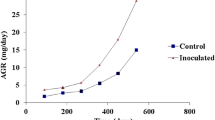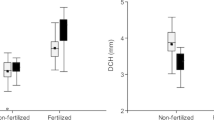Abstract
The ecological, economic and social values of the ectomycorrhizal fungi of the black truffle found in the rural Mediterranean are well known. The inoculation of Pinus halepensis seedlings with mycorrhizal fungi and rhizobacteria can improve the morphology and physiology of the seedlings and benefit the regeneration of arid regions and the reintroduction of inocula of mycorrhizal fungi into these areas. Some rhizobacteria can improve the establishment and functioning of ectomycorrhizal symbiosis. In this study, seedlings of P. halepensis were inoculated with the mycorrhizal fungus Tuber melanosporum and the rhizobacteria Pseudomonas fluorescens CECT 844 under non-limiting greenhouse conditions. Five months after inoculation, we analysed the growth, water parameters (osmotic potential at saturation, osmotic potential at turgor loss and modulus of elasticity), concentrations of mycorrhizal colonies, nutrient concentration and nutrient contents (N, P, K, Ca, Mg and Fe) in roots and aerial parts of the seedlings. Subsequently, tests were performed to estimate the root growth potentials. None of the treatments changed the water parameters or growth potentials of the roots. The inoculations improved the growth and nutrient uptake of the seedlings, although the combination of P. fluorescens CECT 844 and T. melanosporum did not generally lead to a significant improvement over the positive effects of a simple inoculation of T. melanosporum; however, the addition of P. fluorescens CECT 844 did double the rate of the mycorrhization of T. melanosporum. These results may be promising for enhancing the cultivation of truffles.
Similar content being viewed by others

References
Abrams M, Kubiscke ME (1994) Synchronous changes in tissue water parameters of mature foliage from well-watered and periodically droughted tree seedlings. J Exp Bot 45:171–177
Agerer R (1987–1998) Colour atlas of ectomycorrhizae. Einhorn-Verlag, Munich
Barbieri E, Guidi C, Bertaux J, Frey-Klett P, Garbaye J, Ceccaroli P, Saltarelli R, Zambonelli A, Stocchi V (2007) Ocurrence and diversity of bacterial communities in Tuber magnatum during truffle maturation. Environ Microbiol 9:2234–2246
Barea JM (1997) Mycorrhiza/bacteria interactions on plant growth promotion. In: Ogoshi A, Kobayashi L, Homma Y, Kodama F, Kondon N, Akino S (eds) Plant growth-promoting rhizobacteria, present status and future prospects. OCDE, Paris, pp 150–158
Benlloch-González M, Arquero O, Fournier JM, Barranco D, Benlloch M (2008) K+ starvation inhibits water-stress-induced stomatal closure. J Plant Physiol 165:623–630
Boiero L, Perrig D, Masciarelli O, Pena C, Cassán F, Luna V (2007) Phytohormone production by strains of Bradyrhizobium japonicum and possible physiological and technological implications. Appl Microbiol Biotechnol 74:874–880
Bolton HJ, Fredickson JK, Elliott LF (1993) Microbial ecology of the rhizosphere. In: Metting FBJ (ed) Soil microbial ecology. Marcel Dekker, New York, pp 27–63
Bowman WD, Roberts SW (1985) Seasonal changes in tissue elasticity in chaparral shrubs. Physiol Plant 65:233–236
Burdett AN (1987) Understanding root growth capacity: theoretical considerations in assessing planting stock quality by means of root growth tests. Can J For Res 17:768–775
Caravaca F, Alguacil MM, Azcón R, Parladé J, Torres P, Roldán A (2005) Establishment of two ectomycorrhizal shrub species in a semiarid site after in situ amendment with sugar beet, rock phosphate, and Aspergillus níger. Microb Ecol 49:73–82
Chanway CP (1997) Inoculation of tree roots with plant growth promoting soil bacteria: an emerging technology for reforestation. Forest Sci 43:99–112
Cheung YNS, Tyree MT, Dainty J (1975) Water relations parameters on single leaves obtained in a pressure bomb and some ecological interpretations. Can J Bot 53:1342–1346
Citterio B, Malatesta M, Battistelli S, Marcheggiani F, Baffone W, Saltarelli R, Stocchi V, Gazzanelli G (2001) Possible involvement of Pseudomonas fluorescens and Bacillaceae in structural modifications of Tuber borchii fruit bodies. Can J Microbiol 47(3):264–268
Deveau A, Palin B, Delaruelle C, Peter M, Kohler A, Pierrat JC, Sarniguet A, Garbaye J, Martin F, Frey-Klett P (2007) The mycorrhiza helper Pseudomonas fluorescens BBc6R8 has a specific effect on the growth, morphology and gene expression of the ectomycorrhizal fungus Laccaria bicolour S238N. New Phytol 175:743–755
Domínguez JA (2002) Aportaciones de la micorrizacion artificial con trufa negra en planta forestal. Tesis Doctoral de la E.T.S.I. de Montes. Universidad Politécnica de Madrid
Domínguez JA, Lopez C, Rodríguez Barreal JA, Saiz de Omeñaca JA (2003) Caracterización de rodales truferos en la comunidad valenciana. Ecología 17:181–190
Domínguez JA, Planelles R, Rodríguez Barreal JA, Saiz De Omeñaca JA (2004) Influencia de la micorrización con trufa negra en el crecimiento, intercambio gaseoso y nutrición mineral de plántulas de Pinus halepensis. Revista de Investigación Agraria. Serie Sistemas y Recursos Forestales 13(2):317–327
Domínguez JA, Selva J, Rodríguez Barreal JA, Saiz de Omeñaca JA (2006) The influence of mycorrhization with Tuber melanosporum in the afforestation of a Mediterranean site with Quercus ilex and Quercus faginea. Forest Ecol Manag 231:226–233
Domínguez JA, Planelles R, Rodríguez Barreal JA, Saiz de Omeñaca JA (2008) The effect of Tuber melanosporum Vitt. mycorrhization on growth, nutrition, and water relations of Quercus petraea Liebl., Quercus faginea Lamk., and Pinus halepensis Mill. seedlings. New Forests 35:159–171
Frey-Klett P, Garbaye J, Tarkka M (2007) The Mycorrhiza helper bacteria revisited. Tansley Review. New Phytol 176:22–36
Heinonsalo J, Frey-Klett P, Pierrat JC, Churin JL, Vairelles J, Garbaye J (2004) Fate, tree growth effect and potential impact on soil microbial communities of mycorrhizal and bacterial inoculation in a forest plantation. Soil Biol Biochem 36(2):211–216
Jones MM, Turner NC (1980) Osmotic adjustment in expanding and fully expanded leves of sunlower in response to water deficits. Aust J Plant Physiol 7:181–192
Karabaghli C, Frey-Klett P, Sotta B, Bonnet M, Le Tacon F (1998) In vitro effects of Laccaria bicolor S238 N and Pseudomonas fluorescens strain BBc6 on rooting of derooted shoot hypocotyls of Norway spruce. Tree Physiol 18:103–111
Maestre FT, Cortina J (2004) Are Pinus halepensis plantations useful as a restauration tool in semiarid Mediterranean areas? For Ecol Manag 198:303–317
Martínez-Ferri E, Balaguer L, Valladares F, Chico JM, Manrique E (2000) Energy dissipation in drought-avoiding and drought-tolerant tree species at midday during the Mediterranean summer. Tree Physiol 20:131–138
Marulanda A, Barea JM, Azcon R (2006) An indigenous drought-tolerant strain of Glomus intraradices associated with a native bacterium improves water transport and root development in Retama sphaerocarpa. Microbiol Ecol 52:670–678
Matthijs S, Tehrani KA, Laus G, Jackson RW, Cooper RM, Cornelis P (2007) Thioquinolobactin, a Pseudomonas siderophore with antifungal and anti-Pythium activity. Environ Microbiol 9(2):425–434
Olsson PA, Jakobsen I, Wallander H (2002) Foraging and resource allocation strategies of mycorrhizal fungi in a patchy environment. In: Van der Heijden MGA, Sanders IR (eds) Mycorrhizal ecology. Springer, Berlin, pp 93–115
Ouahmane L, Revel JC, Hafidi M, Thioulouse J, Prin Y, Galiana A, Dreyfus B, Duponnois R (2009) Responses of Pinus halepensis growth, soil microbial catabolic functions and phosphate-solubilizing bacteria after rock phosphate amendment and ectomycorrhizal inoculation. Plant Soil 320:169–179
Probanza A, Mateos JL, Lucas GJA, Ramos B, De Felipe MR, Gutierrez MFJ (2001) Effects of inoculation with PGPR Bacillus and Pisolithus tinctorius on Pinus pinea L. Growth, bacterial rhizosphere colonization, and mycorrhizal infection. Microb Ecol 41:140–148
Reyna S (2007) Truficultura. Fundamentos y Técnicas. Ed. Mundi-Prensa, Madrid, pp. 688
Rincón A, Ruiz-Díez B, García-Fraile S, Lucas-García JA, Fernández-Pascual M, Pueyo JJ, De Felipe MR (2005) Colonization of Pinus halepensis roots by Pseudomonas fluorescens and interaction with the ectomycorrhizal fungus Suillus granulatus. FEMS Microbiol Ecol 51:303–311
Rincón A, de Felipe MR, Fernández-Pascual M (2007) Inoculation of Pinus halepensis Mill. with selected ectomycorrhizal fungi improves seedling establishment 2 years after planting in a degraded gypsum soil. Mycorrhiza 18:23–32
Rincón A, Valladares F, Gimeno TE, Pueyo JJ (2008) Water stress responses of two Mediterranean tree species influenced by native soil microorganisms and inoculation with a plant growth promoting rhizobacterium. Tree Physiol 28:1693–1701
Rivera C, Blanco D, Oria R, Venturini ME (2010) Diversity of culturable microorganisms and occurrence of Listeria monocytogenes and Salmonella spp. in Tuber aestivum and Tuber melanosporum ascocarps. Food Microbiology 27:286–293
Robichaux RH (1984) Variation in the tissue water relations of two sympatric Hawaiian Dubautia species and their natural hybrid. Oecologia (Berlin) 65:75–81
Sardans J, Rodá F, Peñuelas J (2006) Effects of a nutrient pulse supply on nutrient status of the Mediterranean trees Quercus ilex subsp. ballota and Pinus halepensis on different soils and under different competitive pressure. Trees 20:619–632
Scholander PF, Hammel HT, Bradstreet ED, Hemmingsen EA (1965) Sap pressure in vascular plants. Science 148:339–346
Silby MW, Cerdeño-Tárraga AM, Vernikos GS, Giddens SR, Jackson RW, Preston GM, Zhang XX, Moon CD, Gehrig SM, Godfrey SA, Knight CG, Malone JG, Robinson Z, Spiers AJ, Harris S, Challis GL, Yaxley AM, Harris D, Seeger K, Murphy L, Rutter S, Squares R, Quail MA, Saunders E, Mavromatis K, Brettin TS, Bentley SD, Hothersall J, Stephens E, Thomas CM, Parkhill J, Levy SB, Rainey PB, Thomson NR (2009) Genomic and genetic analyses of diversity and plant interactions of Pseudomonas fluorescens. Genome Biol 10(5):R51
Simard SW, Jones MD, Durral DM (2002) Carbon and nutrient fluxes within and between mycorrhizal plants. In: van der Heijden MGA, Sanders I (eds) Mycorrhizal ecology. Springer, Berlin, pp 34–74
Smith SE, Read DJ (1997) Mycorrhizal symbiosis, 2nd edn. Academic, London, p 605
Stewart J, Lieffers VJ (1993) Preconditioning effects of nitro gen relative addition rate and drought stress on container-grown lodgepole pine seedlings. Can J For Res 23:1663–1671
Mt T, Frey-Klett P (2008) Mycorrhiza helper bacteria. In: Varma A (ed) Mycorrhiza. Springer, Berlin, pp 113–132
Tyree M, Hammel HT (1972) The measurement of the turgor pressure and the water relations of plants by the pressure technique. J Exp Bot 23:267–282
Tyree M, Jarvis PG (1982) Water in tissues and cells. In: Lange OL, Nobel PS, Osmond CB, Ziegler H (eds) Encyclopedia of plant physiology, new series, vol. 12B, Physiological plant ecology II. Springer, Berlin, pp 36–77
Villar-Salvador P, Caña L, Peñuelas J, Carrasco I, Domínguez S, Renilla I (1997) Relaciones hídricas y potencial de formación de raíces en plántulas de Pinus halepensis Mill. sometidas a diferentes niveles de endurecimientos por estrés hídrico. Monographs of the Spanish Society of Forest Science 4:81–92
Acknowledgments
This work has been funded as part of the project A/019592/08 “Use of inoculants for sustainable agricultural and forestry production systems” of the PCI-AECID (programme of cooperation between universities and scientific research between Spain and Latin America. Spanish International Cooperation Agency for Development)
Author information
Authors and Affiliations
Corresponding author
Rights and permissions
About this article
Cite this article
Dominguez, J.A., Martin, A., Anriquez, A. et al. The combined effects of Pseudomonas fluorescens and Tuber melanosporum on the quality of Pinus halepensis seedlings. Mycorrhiza 22, 429–436 (2012). https://doi.org/10.1007/s00572-011-0420-0
Received:
Accepted:
Published:
Issue Date:
DOI: https://doi.org/10.1007/s00572-011-0420-0



